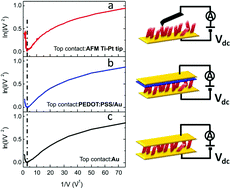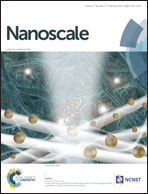Electronic transport regimes through an alkoxythiolated diphenyl-2,2′-bithiophene-based molecular junction diodes: critical assessment of the thermal dependence†
Abstract
The detailed understanding of electronic transport through a single molecule or an ensemble of self-assembled molecules embedded between two metallic leads is still a matter of controversy. Multiple factors influence the charge transport in the molecular junction, with particular attention to be given to the band states of the electrodes, molecular orbital energies, bias potential and importantly molecule–electrode electronic coupling. Moreover it is not trivial to disentangle molecular contributions from other possible conduction pathways directly coupling the opposite electrodes. We here investigate the electronic transport properties of an ensemble molecular junction embedding an alkylthiol derivative of a diphenol substituted bithiophene (DPBT) by means of current vs. voltage and temperature dependent measurements. We explored different junction configurations using: micropores (Au//DPBT//Au and Au//DPBT-polymer conductor//Au) and conductive-atomic force microscopy (c-AFM). In all cases, we found a transition voltage VT of ∼0.35 V. The consistent presence of a similar VT in all the tested configurations is a strong, but not conclusive, indication of a molecular signature in the charge transport, which we assessed and confirmed by temperature dependent measurements. We found a transition from an incoherent resonant tunneling at low biases and close to room temperature, where transport is thermally activated with an activation energy of ∼85 meV, to a coherent tunneling at voltages higher than VT. Unlike many other molecular junctions reported in the literature, resonant conditions commonly attributed to a hopping transport regime can be found already at room temperature and very low biases for a molecule only ∼1.5 nm long. This paper is the first report to clearly show temperature activated transport through a short and not fully conjugated molecule. Moreover, we could clearly identify a regime at low temperatures and low bias where the transport mechanism is controlled by the thermal conductivity of the metal electrodes rather than the molecule.


 Please wait while we load your content...
Please wait while we load your content...